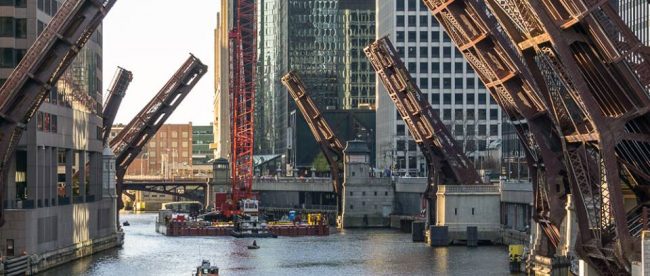The Homeless Man With a Unique Home

Richard Dorsay was homeless, except for the fact that he had a home — small, for sure, but it had a place to sleep, a space heater, a microwave, a television, and even a Sony PlayStation. And the views, wow: Dorsay’s place, situated on the hoity-toity Lake Shore Drive in Chicago, had a unique view of the river.
Actually, one word above isn’t quite true. Dorsay’s tiny home wasn’t actually on Lake Shore Drive. It was, technically, under it.
In order to accommodate both car and ship traffic, the city is outfitted with drawbridges which span the Chicago River. These bridges have all sorts of girders and beams — they’re bridges, after all — and those supports often have gaps, by design. For the city’s homeless population, those gaps can provide a not-uncommon shelter from the wind, rain, and cold temperatures that grip the city during the fall and winter months. Basically: the underside of these bridges is a good way to get out of the cold.
Dorsay’s discovery and subsequent construction went well beyond that, though. One day 2001 or 2002 (according to his claim; the city disputes the timing), he found a 12-inch by 36-inch gap in which he could seek a bit of shelter. He expected to find nothing more than a cubby hole big enough for one person (and barely) to get some momentary relief from conditions outdoors. What he found instead was a much larger opening — news reports don’t give us the dimensions of the space, but it was large enough for all the stuff he’d been lugging around and then some. Over time, the previously nomadic Dorsay gathered more and more items by leveraging his junk collecting, panhandling proceeds, and assistance checks. Further, he realized that from this carve-out under the bridge, he could tap into the city’s electrical grid — and could power a TV, microwave, and more. He turned his secret nook under the bridge into something resembling a home. He’d even have friends over from time to time to watch football over some beers.
There were only two major downsides — well, beyond the obvious ones associated with being homeless and living under a bridge. One, there was no plumbing, but that was easily remedied; the bridgetender’s office, reported architecture site Dornob.com, was often left unlocked, giving Dorsey a nearby place to get some water or use the bathroom. And second, he had to account for the fact that the drawbridge would, at times, open. Per the AP, “whenever Dorsay heard the bells that signal the arms of the bridge would soon rise, he held on as the bridge slowly pitched him forward.” And even then, he made the best of this occasional adventure; he told the AP that “the first time it was scary,” but “after that, it was almost like riding a Ferris wheel.”
While officials claim that they do regular checks of the undersides of bridges in part to account for the homeless who take temporary shelter there, Dorsay claims he went undetected for three years — he hid his house by using blankets as camouflage, reported Chicagoist. What led to his capture was, reportedly, his sense of community. Dorsay didn’t keep his discovery a secret; rather, he told some other homeless in his circles about the opportunities under the bridge and helped them move in. (There are no other reports of anyone else having a TV hookup or, for that matter, electricity in their places.) One of his neighbors was hardly as kind — when the unnamed other bridge dweller was arrested one day, he informed the authorities of Dorsay’s hideaway.
Not only was Dorsay evicted but he was also charged with criminal trespassing, to which he pled guilty. According to the Chicago Tribune, Dorsay “was sentenced to two years of conditional release, 30 days in the Cook County sheriff’s work alternative program and 120 days in jail” minus 15 days for time served. And yes, his under-bridge home was dismantled.
Bonus fact: Like Richard Dorsay, a Phoenix-area man named Richard Leroy Walters was homeless. Unlike Dorsay, Walters didn’t own a TV; rather, he carried a radio around with him. That was probably his biggest source of entertainment, as NPR learned when he died in 2007 at the age of 76. Walters, while homeless, wasn’t poor. A former jet propulsion engineer, he was forced into early retirement and at that moment, began forsaking most material needs and, for that matter, having a roof over his head. He took whatever savings and pension he had and invested it, using a phone at a local community center to manage his money. When he died, his executor distributed his estate per his wishes to ten different non-profits, including NPR. Each gift was approximately $400,000; in total, Walter’s estate was worth $4 million.
From the Archives: McRefugees: Why many of Hong Kong’s McDonald’s have been come de facto homeless shelters.
